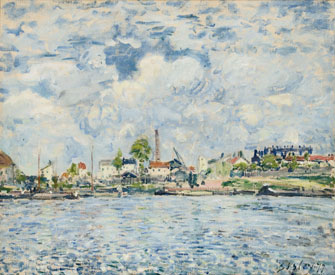Port in a Storm for Artists
Seeking Inspiration & Support

Alfred Sisley’s ”La Seine au Point du Jour” (1877). Musée d’Art Moderne André Malraux © MuMa, le Havre–Florian Kleinefenn
Le Havre in the late-19th and early-20th centuries held great appeal for artists. Its busy port offered plenty of activity and visual stimulation as regal tall-masted ships sailed in and out, while its estuary offered the kind of light and colors sure to delight any painter, especially an Impressionist. Perhaps most importantly, it had a wealth of cotton importers and other tycoons willing to pay for the artists’ output (“No cotton, no paintings,” said local artist Eugène Boudin).
This critical mass helped turn the provincial port city into an unlikely hotbed of modern art before and after the turn of the 20th century, as documented in the new exhibition at Paris’s Musée du Luxembourg, “The Modern Art Club: Avant-Garde Collectors in Le Havre,” which brings together many of the works purchased by the city’s wealthy collectors.
At the epicenter of this artistic explosion was the painter Boudin (1824-98), who moved to Le Havre with his family as a child. He befriended a number of painters, not least among them the young Monet (whom he encouraged to take up painting en plein air) and persuaded others to visit and spend time in Le Havre.
By the mid-19th century, the city had a museum and a Société des Amis des Arts, which became even more active with the advent of a new generation of collectors who took an interest in the work of emerging artists and traveled to Paris to see their work in the galleries and salons. Later, the Cercle de l’Art Moderne brought together both collectors and artists, among them Georges Braque, Raoul Dufy and Emile Othon Friesz.
While not all the paintings in the show are masterpieces, there are many, many gems. Boudin, of course, is well represented by a number of pretty pictures, but it seems clear that he didn’t have the genius of many of those who followed him to Le Havre. In 1874, Boudin and Monet both painted the city’s Bassin du Commerce, and a comparison of the two works shows that the younger artist was already surpassing his mentor with his airy touch and feel for light. In Monet’s “Le Vieux Port du Havre,” painted the same year, the boats in the bustling port seem to be fairly dancing with movement.
The only painting by Camille Corot in the exhibition, a small canvas called “Dunquerque, Remparts et Porte d’Entrée du Port” (1873) is simply lovely. It shows a single spindly tree leaning to one side, echoing the position of the masts of the ships in the port. The only Courbet is rather labored, while the only Delacroix is a bit slapdash, but you can feast your eyes on gorgeous clouds by Johan Barthold Jongkind, a river scene by Camille Pissarro, a mysterious Pointillist landscape in pinks and purples by Henri-Edmond Cross, an almost psychedelic rendering of a ray of sunshine in a grove of trees by Félix Vallotton, some haute Fauve works by André Derain and a sumptuous river scene by Alfred Sisley.
A number of charming works by Albert Marquet, that master of water painting, are included, along with a group of bold female nudes that the collectors kept in special rooms for the eyes of chosen friends only. One interesting example, “La Belle Florence” (1906) by Vallotton, painted in flat, washed-out colors, shows a woman sitting on a wooden chair, leaning against its back and staring frankly at the viewer. It was considered so shocking at the time (presumably because of the woman’s forthright, unashamed expression) that none of the Le Havre collectors would touch it.
Most of these paintings are from Le Havre’s Musée d’Art Moderne André Malraux, whose collection of Impressionist paintings is second only to that of the Musée d’Orsay in Paris, thanks to the donation of the collections of two of the wealthy Le Havre collectors, Olivier Senn and Charles-Auguste Marande. No point in going to Le Havre to see it while this show is on in Paris, but a trip there sometime after would surely be worthwhile.
Musée du Luxembourg: 19, rue de Vaugirard, 75006 Paris. Métro: Saint-Sulpice or Odéon. RER: Luxembourg. Tel.: 01 40 13 62 00. Open daily 10am-7:30pm, until 10pm on Friday. Closed Christmas Day. Admission: €11. Through January 6, 2013. www.museeduluxembourg.fr
Reader Michael Barker writes: “Le Havre (with direct trains from Paris-St.Lazare, taking two hours) has been recently declared a World Heritage Site by UNESCO. Much destroyed in World War II, it was rebuilt by master-planner and architect Auguste Perret and his team in the 1950s (a show flat of his imaginative housing schemes can be visited through the tourist office). Perret’s immense, modernist church of St. Joseph, with its stunning stained glass, is a highlight. And there is Le Volcan cultural center by Oscar Niemeyer. Although works of the Musée des Beaux Arts are currently on show in Paris as per your review, it is still worth visiting this excellent museum. The nearby resort of Sainte-Adresse with its Belle-Epoque architecture survived the Allied bombing in 1944. If making a weekend of it, cross the Seine to visit Honfleur.”
Reader reaction: Click here to respond to this article (your response may be published on this page and is subject to editing).
Please support Paris Update by ordering books from Paris Update’s Amazon store at no extra cost. Click on your preferred Amazon location: U.K., France, U.S.
More reviews of Paris art shows.
© 2012 Paris Update
